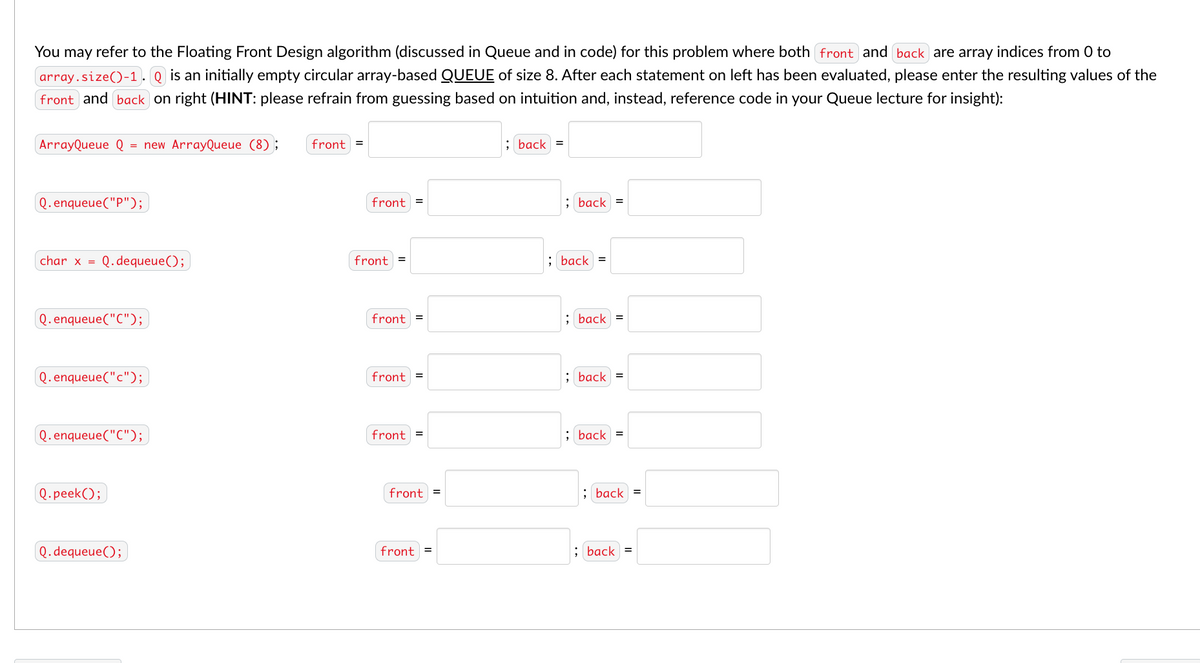You may refer to the Floating Front Design algorithm (discussed in Queue and in code) for this problem where both front and back are array indices array.size()-1. Q is an initially empty circular array-based QUEUE of size 8. After each statement on left has been evaluated, please enter the result front and back on right (HINT: please refrain from guessing based on intuition and, instead, reference code in your Queue lecture for insight): ArrayQueue Q - new ArrayQueue (8); front = ; back = Q. enqueue("P"); front= : back = char x = Q. dequeue(); front = ; back = Q. enqueue("C"); front = : back = Q. enqueue("c"); front = ; back = Q. enqueue("C");) front = : back = Q. peek(); front = ; back = Q.dequeue(); | front = ; back =
You may refer to the Floating Front Design algorithm (discussed in Queue and in code) for this problem where both front and back are array indices array.size()-1. Q is an initially empty circular array-based QUEUE of size 8. After each statement on left has been evaluated, please enter the result front and back on right (HINT: please refrain from guessing based on intuition and, instead, reference code in your Queue lecture for insight): ArrayQueue Q - new ArrayQueue (8); front = ; back = Q. enqueue("P"); front= : back = char x = Q. dequeue(); front = ; back = Q. enqueue("C"); front = : back = Q. enqueue("c"); front = ; back = Q. enqueue("C");) front = : back = Q. peek(); front = ; back = Q.dequeue(); | front = ; back =
Database System Concepts
7th Edition
ISBN:9780078022159
Author:Abraham Silberschatz Professor, Henry F. Korth, S. Sudarshan
Publisher:Abraham Silberschatz Professor, Henry F. Korth, S. Sudarshan
Chapter1: Introduction
Section: Chapter Questions
Problem 1PE
Related questions
Question
Java data structure question

Transcribed Image Text:You may refer to the Floating Front Design algorithm (discussed in Queue and in code) for this problem where both front and back are array indices from 0 to
array.size()-1. Q is an initially empty circular array-based QUEUE of size 8. After each statement on left has been evaluated, please enter the resulting values of the
front and back on right (HINT: please refrain from guessing based on intuition and, instead, reference code in your Queue lecture for insight):
ArrayQueue Q = new ArrayQueue (8);
front =
; back =
Q.enqueue("P");
front =
; back =
char x =
Q.dequeue();
front =
; back =
Q.enqueue("C");
front =
; back
Q.enqueue("c");
front =
; back =
Q.enqueue("C");
front =
; back =
Q.peek();
front =
; back =
Q.dequeue();
front =
; back =
Expert Solution
This question has been solved!
Explore an expertly crafted, step-by-step solution for a thorough understanding of key concepts.
This is a popular solution!
Trending now
This is a popular solution!
Step by step
Solved in 4 steps with 3 images

Knowledge Booster
Learn more about
Need a deep-dive on the concept behind this application? Look no further. Learn more about this topic, computer-science and related others by exploring similar questions and additional content below.Recommended textbooks for you

Database System Concepts
Computer Science
ISBN:
9780078022159
Author:
Abraham Silberschatz Professor, Henry F. Korth, S. Sudarshan
Publisher:
McGraw-Hill Education

Starting Out with Python (4th Edition)
Computer Science
ISBN:
9780134444321
Author:
Tony Gaddis
Publisher:
PEARSON

Digital Fundamentals (11th Edition)
Computer Science
ISBN:
9780132737968
Author:
Thomas L. Floyd
Publisher:
PEARSON

Database System Concepts
Computer Science
ISBN:
9780078022159
Author:
Abraham Silberschatz Professor, Henry F. Korth, S. Sudarshan
Publisher:
McGraw-Hill Education

Starting Out with Python (4th Edition)
Computer Science
ISBN:
9780134444321
Author:
Tony Gaddis
Publisher:
PEARSON

Digital Fundamentals (11th Edition)
Computer Science
ISBN:
9780132737968
Author:
Thomas L. Floyd
Publisher:
PEARSON

C How to Program (8th Edition)
Computer Science
ISBN:
9780133976892
Author:
Paul J. Deitel, Harvey Deitel
Publisher:
PEARSON

Database Systems: Design, Implementation, & Manag…
Computer Science
ISBN:
9781337627900
Author:
Carlos Coronel, Steven Morris
Publisher:
Cengage Learning

Programmable Logic Controllers
Computer Science
ISBN:
9780073373843
Author:
Frank D. Petruzella
Publisher:
McGraw-Hill Education